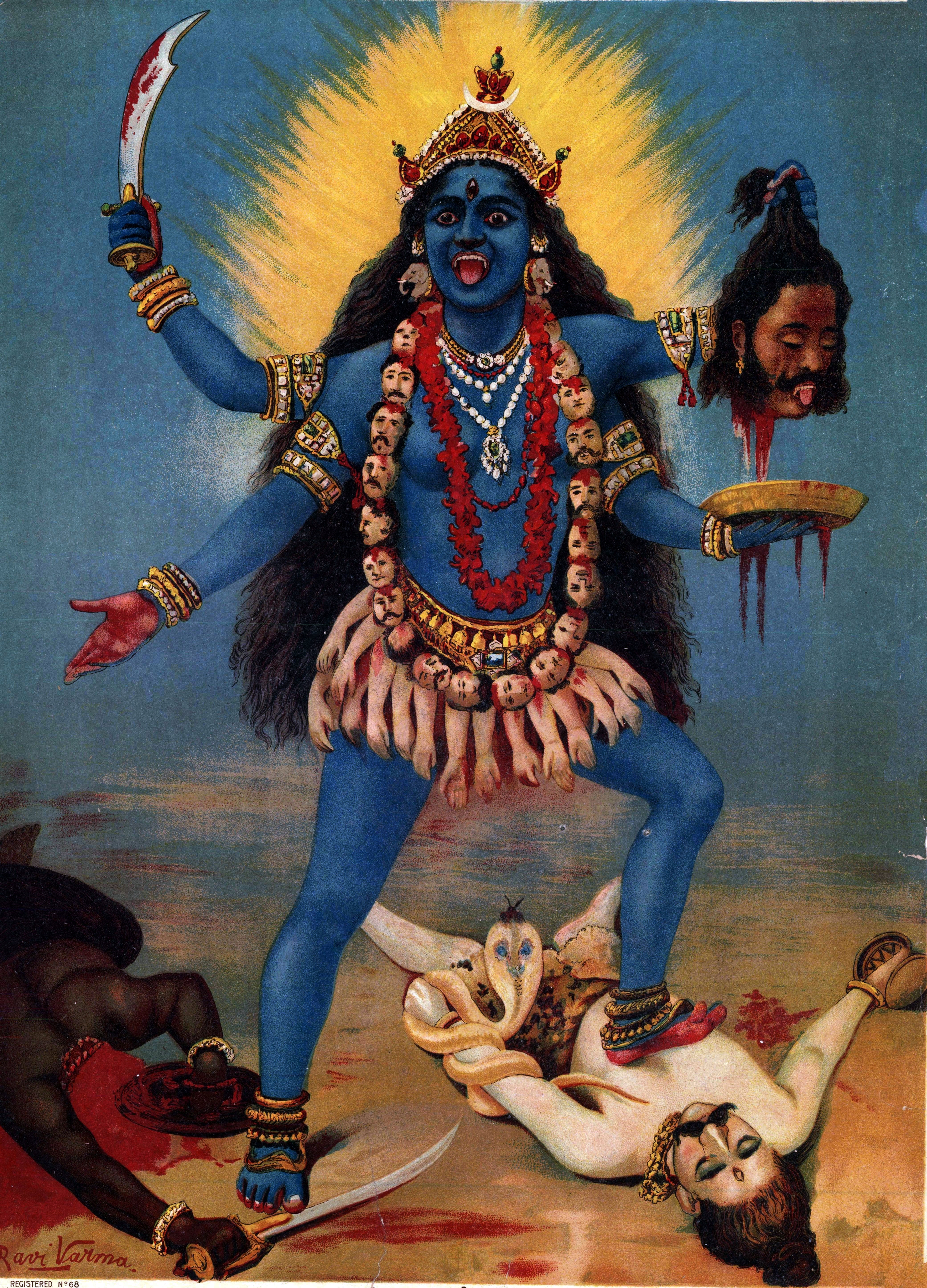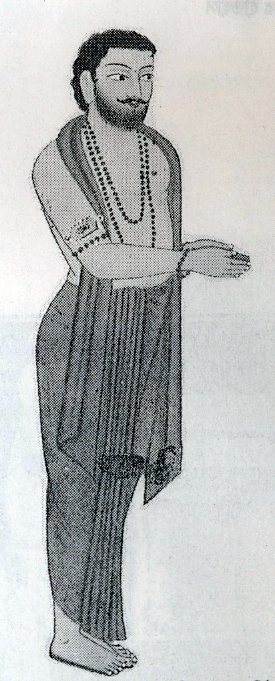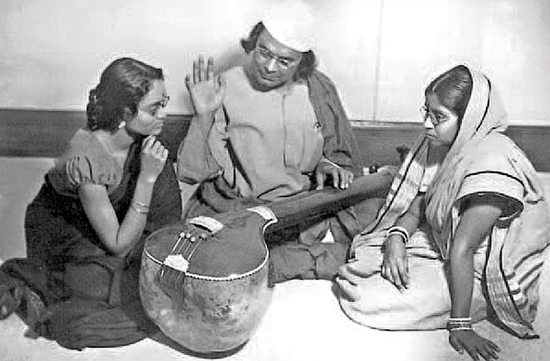|
Ramprasadi
Ramprasadi (Bengali: রামপ্রসাদী) is the songs composed by eighteenth century Bengali saint-poet Ramprasad Sen. They are usually addressed to Hindu goddess Kali and written in Bengali language.Singing to the Goddess: Poems to Kali and Uma from Bengal, Ramprasad Sen, Translated by Rachel Fell McDermott ()History of Bengali Literature, Dr. Dulal Chakraborty, July - 2007, Bani Bitan. (Bengali) Influence Ramprasad Sen was the first shakta poet to address Kali with such as intimate devotion and to sing of her as a tender loving mother or even as a little girl. He is credited with creating a new compositional form that combined the Bengali folk style of Baul music with classical melodies and kirtan. After him, a school of shakta poets continued the Kali-bhakti tradition. Krishna Chandra Roy, Siraj ud-Daulah, Rabindranath Tagore, Kazi Nazrul Islam were immensely inspired by the songs of Ramprasad. Many of his songs were sung by famous Shyama sangeet singers like ... [...More Info...] [...Related Items...] OR: [Wikipedia] [Google] [Baidu] |
Ramprasad Sen
( bn, রামপ্রসাদ সেন; c. 1718 or c. 1723 – c. 1775) was a Hindu Shakta poet and saint of eighteenth century Bengal. His '' bhakti'' poems, known as Ramprasadi, are still popular in Bengal—they are usually addressed to the Hindu goddess Kali and written in Bengali., p. 162 Stories of Ramprasad's life typically include legends and myths mixed with biographical details. It is said that, Ramprasad was born into a Bengali Baidya family, and showed an inclination towards poetry from an early age. He was highly influenced by Krishnananda Agamavagisha, a Tantric scholar and yogi. Ramprasad became well known for his devotional songs. His life has been the subject of many stories depicting his devotion to, and relationship with, Kali. Ramprasad's literary works include ''Vidyasundar'', ''Kali-kirtana'', ''Krishna-kirtana'' and ''Shaktigiti''. Ramprasad is credited with creating a new compositional form that combined the Bengali folk style of Baul mus ... [...More Info...] [...Related Items...] OR: [Wikipedia] [Google] [Baidu] |
Music Of West Bengal
The music of West Bengal includes multiple indigenous musical genres such as Baul, Ramprasadi, Bishnupuri Classical, Kirtan, Shyama Sangeet, Rabindra Sangeet, Nazrul Geeti, Dwijendrageeti, Prabhat Samgiita, Agamani-Vijaya, Patua Sangeet, Gambhira, Bhatiali, Bhawaiya, Bengali Rock. Classical music Ragapradhan Gaan Bengali classical music is based on modes called ''ragas''. In composing these songs, the melodies of ''North Indian ragas'' are used. As far as the ''Charyagiti'' (9th century), ragas have been used in Bengali music. Jaydev's ''Gita Govinda'', ''Padavali Kirtan'', ''Mangal Giti'', ''Shyama sangeet'', ''Tappa'', ''Brahma Sangeet'' and ''Tagore songs'' have been inspired by Ragas. The use of ''North Indian ragas'' in Bangla songs began in 18th century. This trend gathered momentum during the 19th and 20th centuries. The pioneers of these trend were Ramnidhi Gupta of North Kolkata, Kali Mirza of Hooghly, Raghunath Roy and the founder of the Bishnupur Gharana, ... [...More Info...] [...Related Items...] OR: [Wikipedia] [Google] [Baidu] |
Bengali Music
Bengali music ( bn, বাংলা সংগীত) comprises a long tradition of religious and secular song-writing over a period of almost a millennium. Composed with lyrics in the Bengali language, Bengali music spans a wide variety of styles. The Bengal region of the Indian subcontinent is currently split between the Indian state of West Bengal and the country of Bangladesh. West Bengal is still referred to as Bengal in the rest of India. History The earliest music in Bengal was influenced by Sanskrit chants, and evolved under the influence of Vaishnav poetry such as the 13th-century '' Gitagovindam'' by Jayadeva, whose work continues to be sung in many eastern Hindu temples. The Middle Ages saw a mixture of Hindu and Islamic trends when the musical tradition was formalized under the patronage of Sultan and Nawabs and the powerful landlords '' baro bhuiyans''. Much of the early canon is devotional, as in the Hindu devotional songs of Ramprasad Sen a bhakta who cap ... [...More Info...] [...Related Items...] OR: [Wikipedia] [Google] [Baidu] |
Music Of Bengal
Bengali music ( bn, বাংলা সংগীত) comprises a long tradition of religious and secular song-writing over a period of almost a millennium. Composed with lyrics in the Bengali language, Bengali music spans a wide variety of styles. The Bengal region of the Indian subcontinent is currently split between the Indian state of West Bengal and the country of Bangladesh. West Bengal is still referred to as Bengal in the rest of India. History The earliest music in Bengal was influenced by Sanskrit chants, and evolved under the influence of Vaishnav poetry such as the 13th-century '' Gitagovindam'' by Jayadeva, whose work continues to be sung in many eastern Hindu temples. The Middle Ages saw a mixture of Hindu and Islamic trends when the musical tradition was formalized under the patronage of Sultan and Nawabs and the powerful landlords '' baro bhuiyans''. Much of the early canon is devotional, as in the Hindu devotional songs of Ramprasad Sen a bhakta who cap ... [...More Info...] [...Related Items...] OR: [Wikipedia] [Google] [Baidu] |
Dhananjay Bhattacharya
Dhananjay Bhattacharya (September 10, 1922 – December 27, 1992) was an Indian Bengali singer and composer. He was a versatile Shyama Sangeet singer. Career He started his career by singing modern Bengali as well as Hindi songs. His first song was "Jodi bhule jao more/janabo na abhiman..." in 1940, recorded with Pioneer Company. His first playback was in 1943. He was best known for singing Shyama Sangeet. Out of the 24 songs in the movie ''Sadhak Ramprasad'' (1956), Dhananjay sang 23. He was versatile in singing major types and forms of songs including modern Bengali, Hindustani classical music, Rabindra Sangeet, Kirtan, Bhajan, Baul, Ramprasadi (of Ramprasad Sen), Nazrul Geeti, and Shyama Sangeet. His singing career lasted more than fifty years. There are 500 records of his songs. He was also a lyricist and wrote about 400 songs in the name of "Shri Partha" and "Shri Ananda". He acted in a few films, including ''"Nababidhan'' and ''Pasher Bari''. In the latter, his song "Jh ... [...More Info...] [...Related Items...] OR: [Wikipedia] [Google] [Baidu] |
Krishnachandra Roy
Raja Krishnachandra (born Krishnachandra Ray, (1710–1783) was a raja and zamindar of , Nadia, from 1728 to 1782. He belonged to the Nadia Raj family and Shakta Hindu tradition. He is credited not only with his resistance to the Mughal rule, but with his expansion and patronage of the arts in his kingdom. Reign According to Atul Chandra Roy, Krishnachandra was “the most important man of the period in the Hindu society of Bengal.” During his reign, Krishnachandra was highly influential for Hindu religious practices, for which reason Raja Rajballabh Sen of Bikrampur sought the assistance of Krishnachandra's pandits in supporting the overturning of the prohibition on widow remarriage after his own daughter was widowed young. However, Krishnachandra strongly opposed the measure. To illustrate his feelings, legend relates, he had the visitors served the meat of a buffalo calf. Offended, they rejected the food on their honor as orthodox Hindus, and when challenged indicated ... [...More Info...] [...Related Items...] OR: [Wikipedia] [Google] [Baidu] |
Pannalal Bhattacharya
Pannalal Bhattacharya (c. 1930 – 27 March 1966) was an Indian singer of Bengali music. Most of the songs he sang were written by Ramprasad Sen and Kamalakanta Bhattacharya, both of whom were Shakta poets of Bengal. He was eight years younger than his elder brother Dhananjay Bhattacharya. He developed a special style of singing, Shyama Sangeet, that continues to be used. He committed suicide at the age of 36. Pannalal Bhattacharya is the evergreen singer of Bengali music industry. Pannalal Bhattacharya is a great Matri Bhakta. Early life Very little is known about his background. Even the Bengali 'Cąritavidan' does not provide adequate information about his early life or childhood. He was born in Bally, Barendrapara, Howrah and spent most of his life there. Career Pannalal started singing in 1947, at the age of 17, with another renowned musician, Sanat Sinha. His elder brother Prafulla took them both to a program, where none of them were allowed to sing because of the immatur ... [...More Info...] [...Related Items...] OR: [Wikipedia] [Google] [Baidu] |
Kazi Nazrul Islam
Kazi Nazrul Islam ( bn, কাজী নজরুল ইসলাম, ; 24 May 1899 – 29 August 1976) was a Bengali poet, Bengali literature, writer, Bangladeshi music, musician, and is the national poet of Bangladesh. Nazrul is regarded as one of the greatest poets in Bengali literature. Popularly known as Nazrul, he produced a Complete Works of Kazi Nazrul Islam, large body of poetry, music, messages, novels, stories, etc. with themes that included equality, justice, anti-imperialism, humanity, rebellion against oppression and religious devotion. Nazrul's activism for political and social justice as well as writing a poem titled as "Bidrohī", meaning "the rebel" in Bengali, earned him the title of "Bidrohī Kôbi" (''Rebel Poet''). His compositions form the avant-garde music genre of Nazrul Geeti, Nazrul Gīti (''Music of Nazrul''). Born into a Bengali Muslim Qadi#IndoPak Region, Kazi family hailing from Bardhaman district, Burdwan district in Bengal Presidency (now in West Be ... [...More Info...] [...Related Items...] OR: [Wikipedia] [Google] [Baidu] |
Rabindranath Tagore
Rabindranath Tagore (; bn, রবীন্দ্রনাথ ঠাকুর; 7 May 1861 – 7 August 1941) was a Bengali polymath who worked as a poet, writer, playwright, composer, philosopher, social reformer and painter. He reshaped Bengali literature and music as well as Indian art with Contextual Modernism in the late 19th and early 20th centuries. Author of the "profoundly sensitive, fresh and beautiful" poetry of ''Gitanjali'', he became in 1913 the first non-European and the first lyricist to win the Nobel Prize in Literature. Tagore's poetic songs were viewed as spiritual and mercurial; however, his "elegant prose and magical poetry" remain largely unknown outside Bengal. He was a fellow of the Royal Asiatic Society. Referred to as "the Bard of Bengal", Tagore was known by sobriquets: Gurudev, Kobiguru, Biswakobi. A Bengali Brahmin from Calcutta with ancestral gentry roots in Burdwan district* * * and Jessore, Tagore wrote poetry as an eight-yea ... [...More Info...] [...Related Items...] OR: [Wikipedia] [Google] [Baidu] |
Siraj Ud-Daulah
Mirza Muhammad Siraj-ud-Daulah ( fa, ; 1733 – 2 July 1757), commonly known as Siraj-ud-Daulah or Siraj ud-Daula, was the last independent Nawab of Bengal. The end of his reign marked the start of the rule of the East India Company over Bengal and later almost all of the Indian subcontinent. Siraj succeeded his maternal grandfather, Alivardi Khan as the Nawab of Bengal in April 1756 at the age of 23. Betrayed by Mir Jafar, the commander of Nawab's army, Siraj lost the Battle of Plassey on 23 June 1757. The forces of the East India Company under Robert Clive invaded and the administration of Bengal fell into the hands of the company. Early life and background Siraj was born to the family of Mirza Muhammad Hashim and Amina Begum in 1733. Soon after his birth, Alivardi Khan, Siraj's maternal grandfather, was appointed the Deputy Governor of Bihar. Amina Begum was the youngest daughter of Alivardi Khan and Princess Sharfunnisa, the paternal aunt of Mir Jafar. His father, Mi ... [...More Info...] [...Related Items...] OR: [Wikipedia] [Google] [Baidu] |
Shaktism
Shaktism ( sa, शाक्त, , ) is one of several major Hindu denominations, wherein the metaphysical reality is considered metaphorically a woman and Shakti ( Mahadevi) is regarded as the supreme godhead. It includes many goddesses, all considered aspects of the same supreme goddess. Shaktism has different sub-traditions, ranging from those focused on most worshipped Durga, gracious Parvati to that of fierce Kali. The Sruti and Smriti texts of Hinduism are an important historical framework of the Shaktism tradition. In addition, it reveres the texts '' Devi Mahatmya'', the ''Devi-Bhagavata Purana'', '' Kalika Purana'' and Shakta Upanishads such as the Devi Upanishad. The ''Devi Mahatmya'' in particular, is considered in Shaktism to be as important as the '' Bhagavad Gita''. Shaktism is known for its various sub-traditions of tantra, as well as a galaxy of goddesses with respective systems. It consists of the Vidyapitha and Kulamārga. The pantheon of goddesses in S ... [...More Info...] [...Related Items...] OR: [Wikipedia] [Google] [Baidu] |
Bengali Folk Song
Bengali or Bengalee, or Bengalese may refer to: *something of, from, or related to Bengal, a large region in South Asia * Bengalis, an ethnic and linguistic group of the region * Bengali language, the language they speak ** Bengali alphabet, the writing system ** Bengali–Assamese script *** Bengali (Unicode block), a block of Bengali characters in Unicode * Bengali, Nancowry, a village in Andaman and Nicobar Islands, India * , a ship launched in 1837 and wrecked in 1951 * Bengali, member of the ThunderCats * Bengali-Fodé Koita, Guinean footballer * Bengali Keïta, Guinean centre-back * Bengali Market, ancient market in New Delhi, India * Bengali River, river in northern Bangladesh * Bengali Singh, Indian politician * Abdul Wahid Bengali, 19th-century theologian * Ali Sher Bengali, 16th-century Sufi * Athar Ali Bengali, politician and teacher * Izzatullah Bengali, 18th-century Persian language author * Mohamed Bengali, Ivorian footballer * Muhammad Salih Bengali, 18th-century ... [...More Info...] [...Related Items...] OR: [Wikipedia] [Google] [Baidu] |




